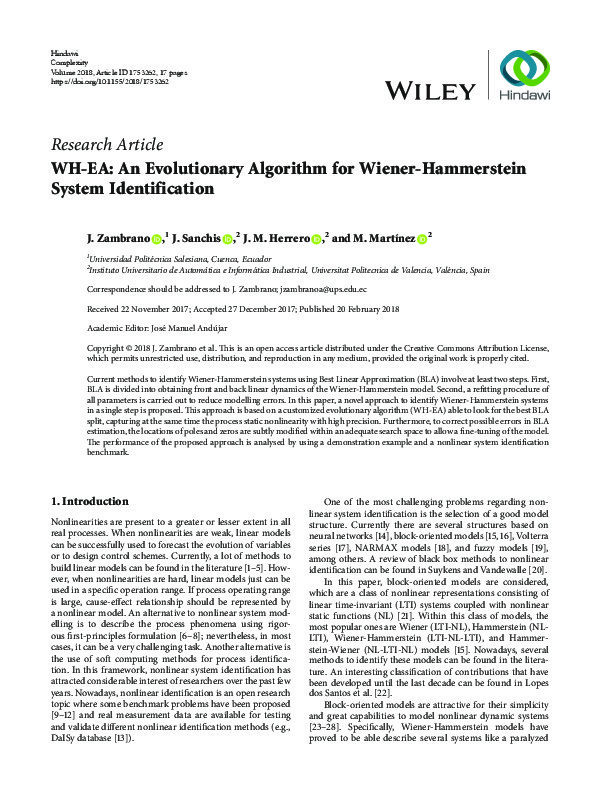Mora, L. A., & Amaya, J. E. (2017). Un Nuevo Método de Identificación Basado en la Respuesta Escalón en Lazo Abierto de Sistemas Sobre-amortiguados. Revista Iberoamericana de Automática e Informática Industrial RIAI, 14(1), 31-43. doi:10.1016/j.riai.2016.09.006
Liu, T., Wang, Q.-G., & Huang, H.-P. (2013). A tutorial review on process identification from step or relay feedback test. Journal of Process Control, 23(10), 1597-1623. doi:10.1016/j.jprocont.2013.08.003
Karnopp, D. C., Margolis, D. L., & Rosenberg, R. C. (2012). System Dynamics. doi:10.1002/9781118152812
[+]
Mora, L. A., & Amaya, J. E. (2017). Un Nuevo Método de Identificación Basado en la Respuesta Escalón en Lazo Abierto de Sistemas Sobre-amortiguados. Revista Iberoamericana de Automática e Informática Industrial RIAI, 14(1), 31-43. doi:10.1016/j.riai.2016.09.006
Liu, T., Wang, Q.-G., & Huang, H.-P. (2013). A tutorial review on process identification from step or relay feedback test. Journal of Process Control, 23(10), 1597-1623. doi:10.1016/j.jprocont.2013.08.003
Karnopp, D. C., Margolis, D. L., & Rosenberg, R. C. (2012). System Dynamics. doi:10.1002/9781118152812
Bonilla, J., Roca, L., de la Calle, A., & Dormido, S. (2017). Modelo Dinámico de un Recuperador de Gases -Sales Fundidas para una Planta Termosolar Híbrida de Energías Renovables. Revista Iberoamericana de Automática e Informática Industrial RIAI, 14(1), 70-81. doi:10.1016/j.riai.2016.11.003
Billings, S. A., & Fakhouri, S. Y. (1982). Identification of systems containing linear dynamic and static nonlinear elements. Automatica, 18(1), 15-26. doi:10.1016/0005-1098(82)90022-x
Lopes dos Santos, P., A. Ramos, J., & Martins de Carvalho, J. L. (2012). Identification of a Benchmark Wiener–Hammerstein: A bilinear and Hammerstein–Bilinear model approach. Control Engineering Practice, 20(11), 1156-1164. doi:10.1016/j.conengprac.2012.04.002
Kalafatis, A., Arifin, N., Wang, L., & Cluett, W. R. (1995). A new approach to the identification of pH processes based on the Wiener model. Chemical Engineering Science, 50(23), 3693-3701. doi:10.1016/0009-2509(95)00214-p
Jurado, F. (2006). A method for the identification of solid oxide fuel cells using a Hammerstein model. Journal of Power Sources, 154(1), 145-152. doi:10.1016/j.jpowsour.2005.04.005
Boubaker, S. (2017). Identification of nonlinear Hammerstein system using mixed integer-real coded particle swarm optimization: application to the electric daily peak-load forecasting. Nonlinear Dynamics, 90(2), 797-814. doi:10.1007/s11071-017-3693-9
S Gaya, M. (2017). Estimation of Turbidity in Water Treatment Plant using Hammerstein-Wiener and Neural Network Technique. Indonesian Journal of Electrical Engineering and Computer Science, 5(3), 666. doi:10.11591/ijeecs.v5.i3.pp666-672
Bai, E.-W., Cai, Z., Dudley-Javorosk, S., & Shields, R. K. (2009). Identification of a modified Wiener–Hammerstein system and its application in electrically stimulated paralyzed skeletal muscle modeling. Automatica, 45(3), 736-743. doi:10.1016/j.automatica.2008.09.023
Haryanto, A., & Hong, K.-S. (2013). Maximum likelihood identification of Wiener–Hammerstein models. Mechanical Systems and Signal Processing, 41(1-2), 54-70. doi:10.1016/j.ymssp.2013.07.008
Gómez, J. C., Jutan, A., & Baeyens, E. (2004). Wiener model identification and predictive control of a pH neutralisation process. IEE Proceedings - Control Theory and Applications, 151(3), 329-338. doi:10.1049/ip-cta:20040438
Li, S., & Li, Y. (2016). Model predictive control of an intensified continuous reactor using a neural network Wiener model. Neurocomputing, 185, 93-104. doi:10.1016/j.neucom.2015.12.048
Zhang, Q., Wang, Q., & Li, G. (2016). Nonlinear modeling and predictive functional control of Hammerstein system with application to the turntable servo system. Mechanical Systems and Signal Processing, 72-73, 383-394. doi:10.1016/j.ymssp.2015.09.011
Ławryńczuk, M. (2016). Nonlinear predictive control of dynamic systems represented by Wiener–Hammerstein models. Nonlinear Dynamics, 86(2), 1193-1214. doi:10.1007/s11071-016-2957-0
Schoukens, M., Pintelon, R., & Rolain, Y. (2014). Identification of Wiener–Hammerstein systems by a nonparametric separation of the best linear approximation. Automatica, 50(2), 628-634. doi:10.1016/j.automatica.2013.12.027
Vanbeylen, L. (2014). A fractional approach to identify Wiener–Hammerstein systems. Automatica, 50(3), 903-909. doi:10.1016/j.automatica.2013.12.013
Sjöberg, J., Lauwers, L., & Schoukens, J. (2012). Identification of Wiener–Hammerstein models: Two algorithms based on the best split of a linear model applied to the SYSID’09 benchmark problem. Control Engineering Practice, 20(11), 1119-1125. doi:10.1016/j.conengprac.2012.07.001
Westwick, D. T., & Schoukens, J. (2012). Initial estimates of the linear subsystems of Wiener–Hammerstein models. Automatica, 48(11), 2931-2936. doi:10.1016/j.automatica.2012.06.091
Tan, A. H., Wong, H. K., & Godfrey, K. (2012). Identification of a Wiener–Hammerstein system using an incremental nonlinear optimisation technique. Control Engineering Practice, 20(11), 1140-1148. doi:10.1016/j.conengprac.2012.04.007
Naitali, A., & Giri, F. (2015). Wiener–Hammerstein system identification – an evolutionary approach. International Journal of Systems Science, 47(1), 45-61. doi:10.1080/00207721.2015.1027758
Schoukens, J., Lataire, J., Pintelon, R., Vandersteen, G., & Dobrowiecki, T. (2009). Robustness Issues of the Best Linear Approximation of a Nonlinear System. IEEE Transactions on Instrumentation and Measurement, 58(5), 1737-1745. doi:10.1109/tim.2009.2012948
Ljung, L., & Singh, R. (2012). Version 8 of the Matlab System Identification Toolbox. IFAC Proceedings Volumes, 45(16), 1826-1831. doi:10.3182/20120711-3-be-2027.00061
[-]









